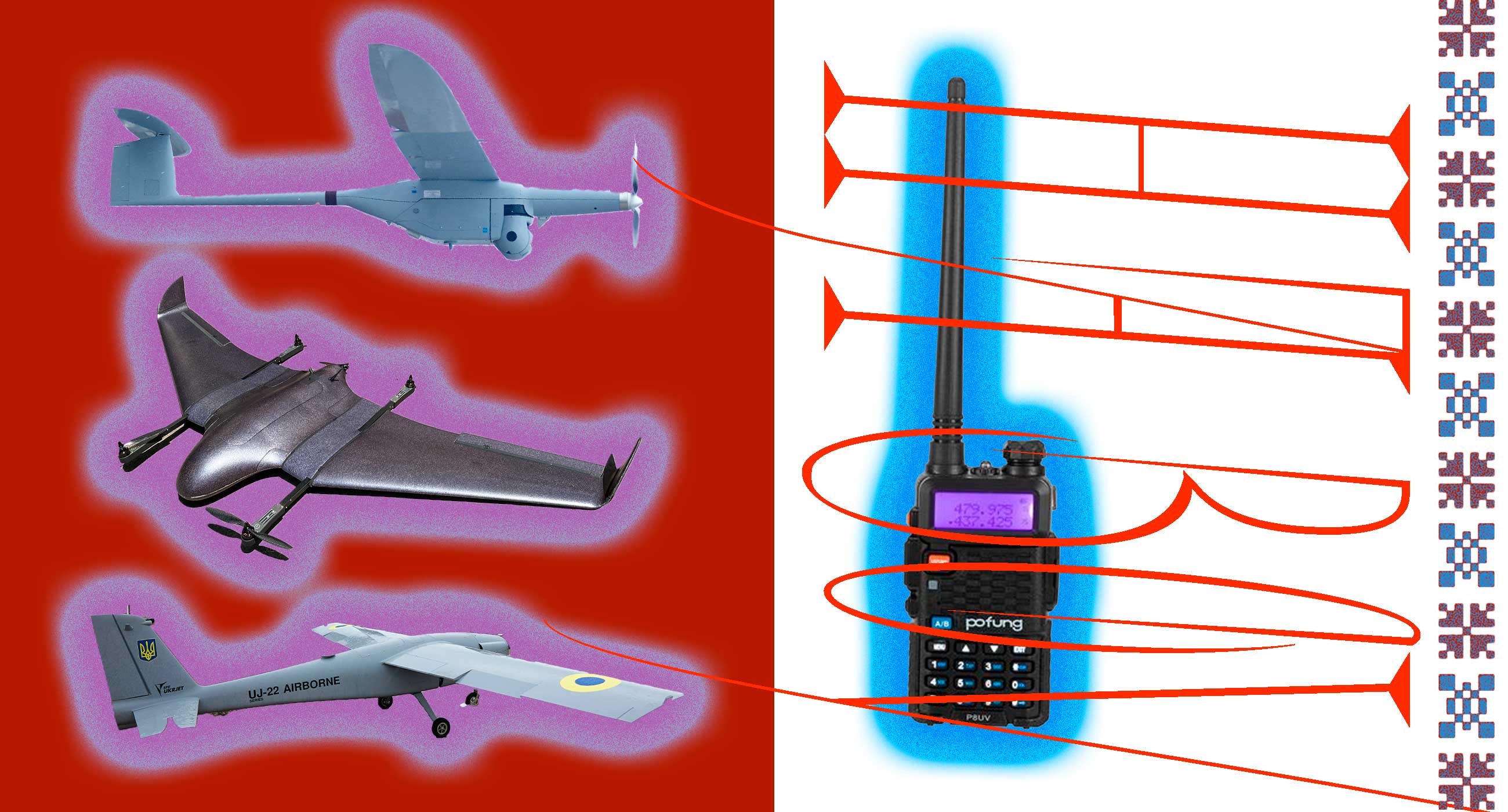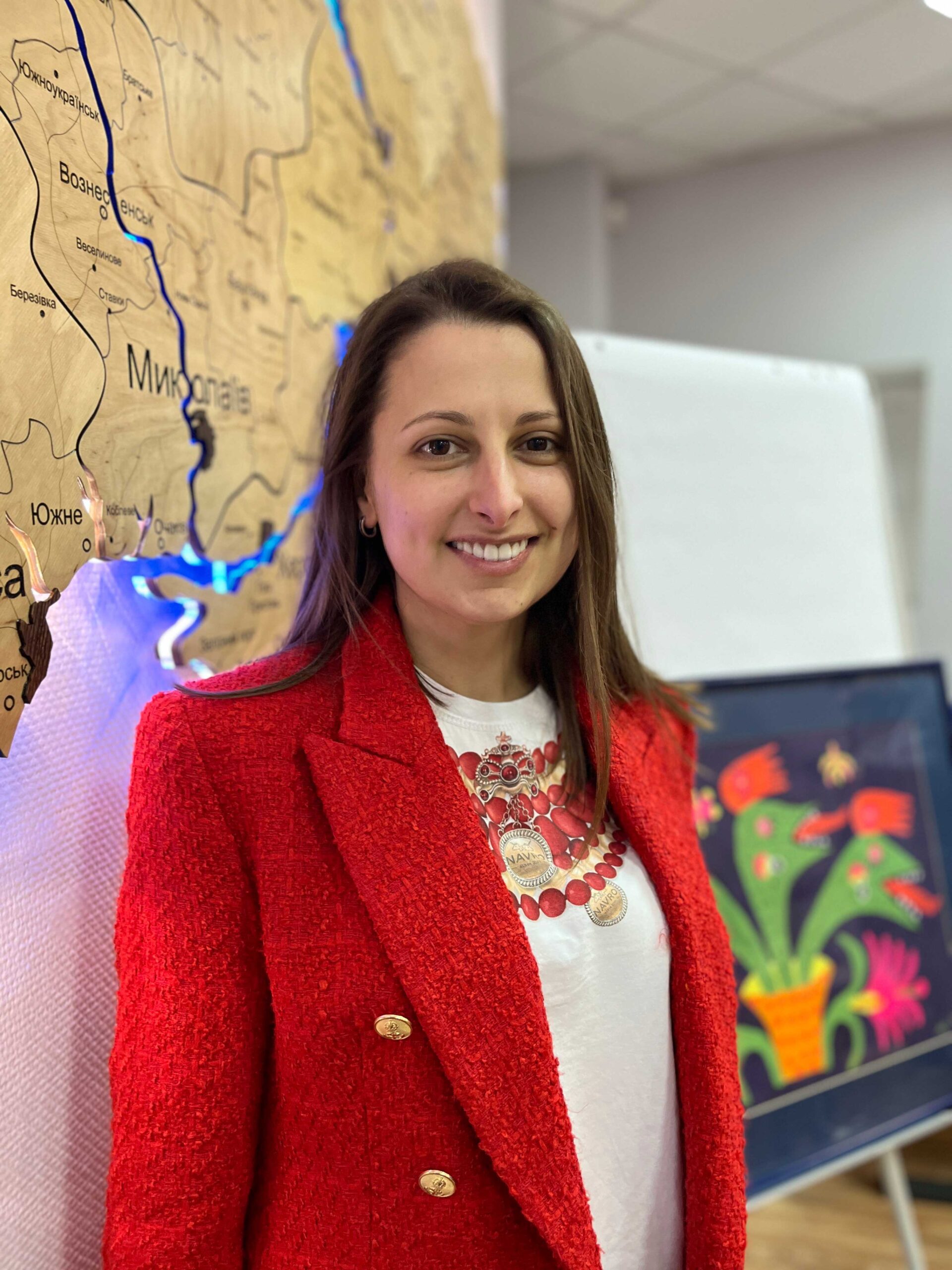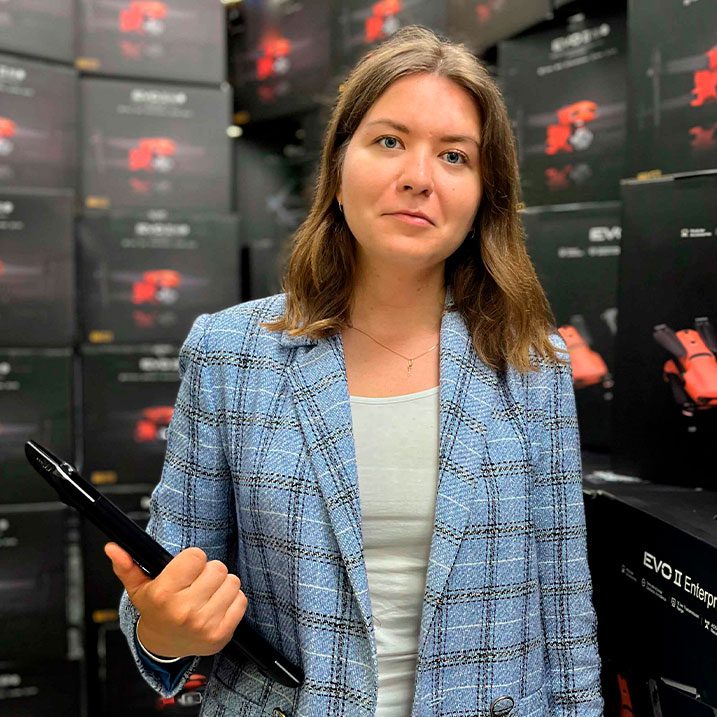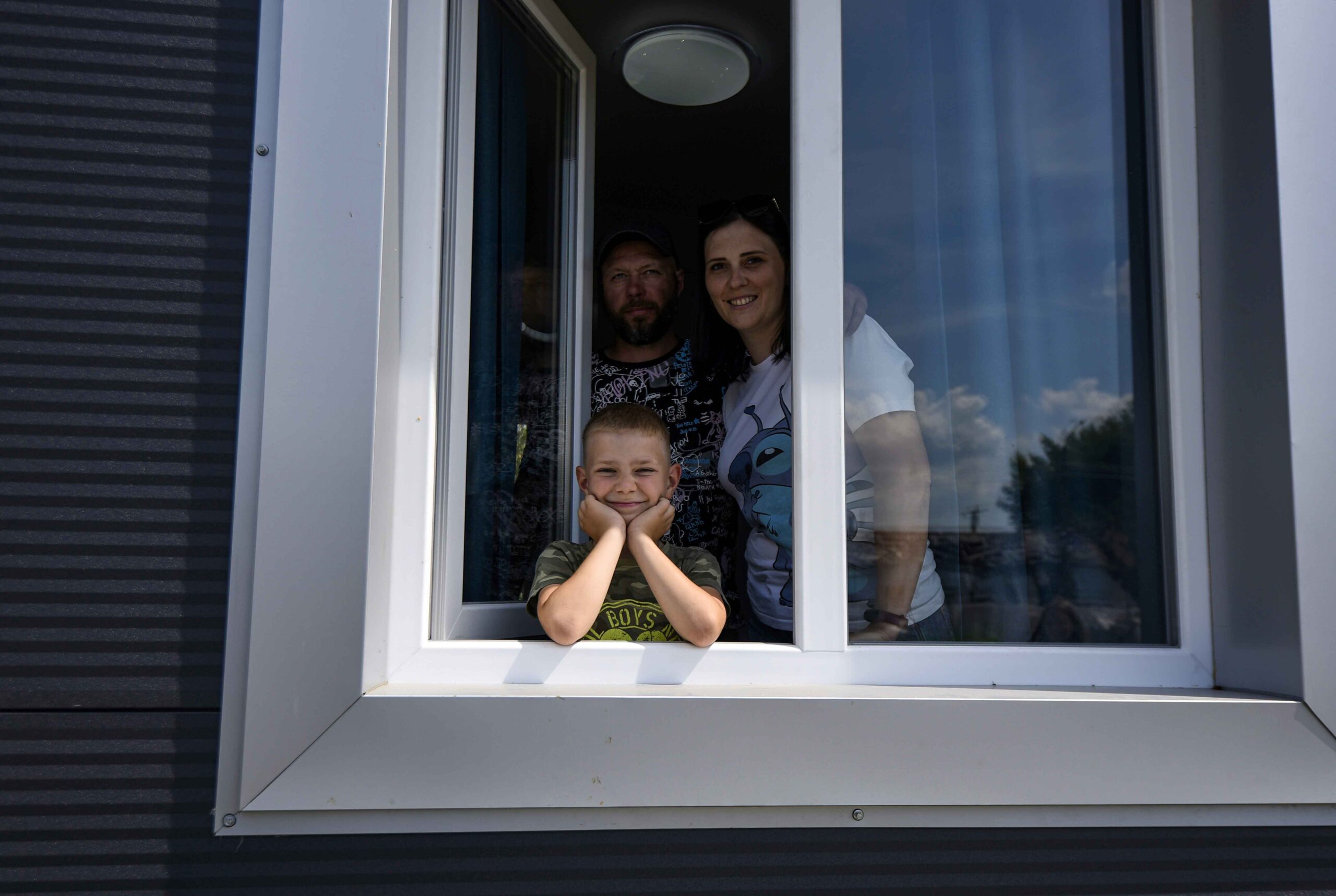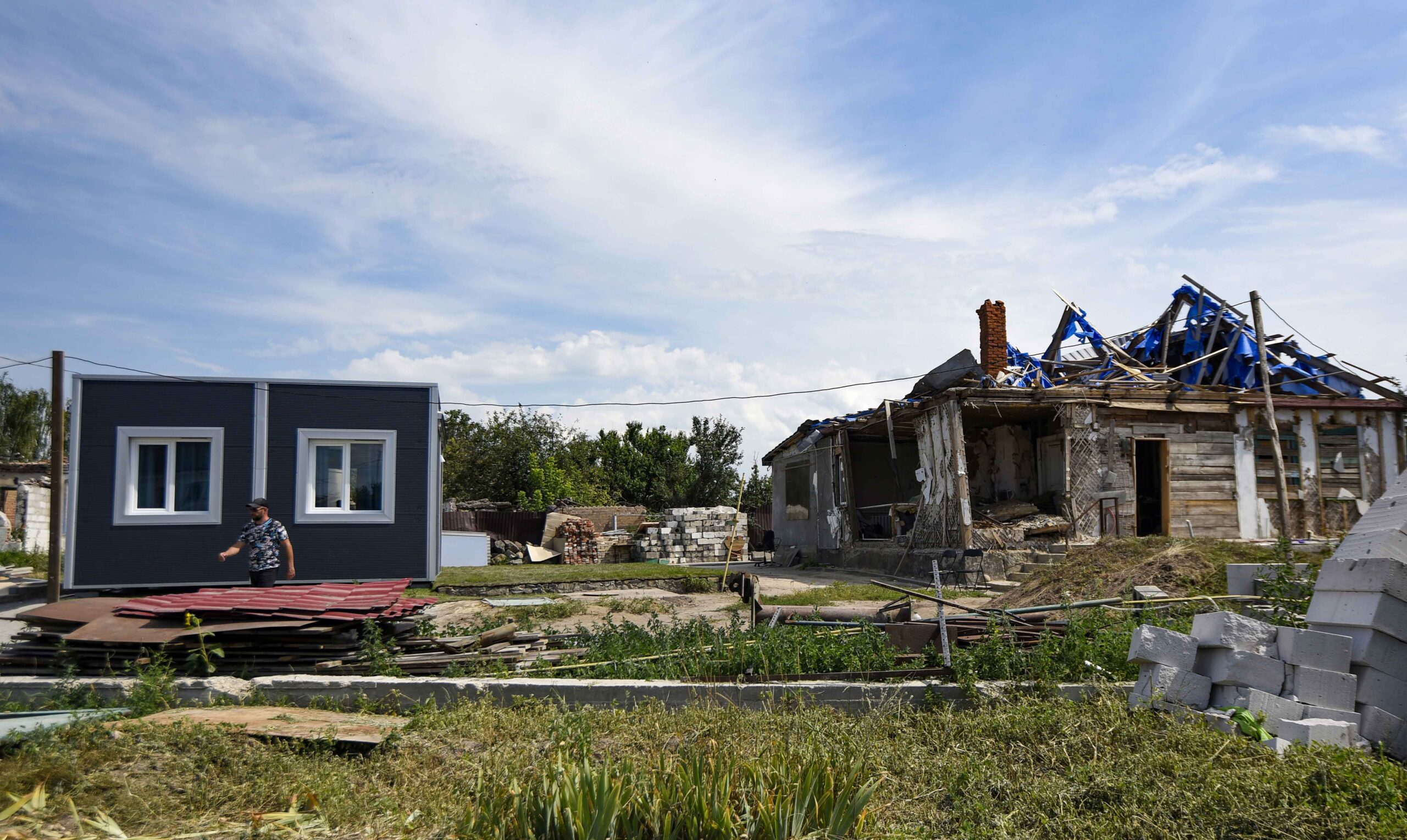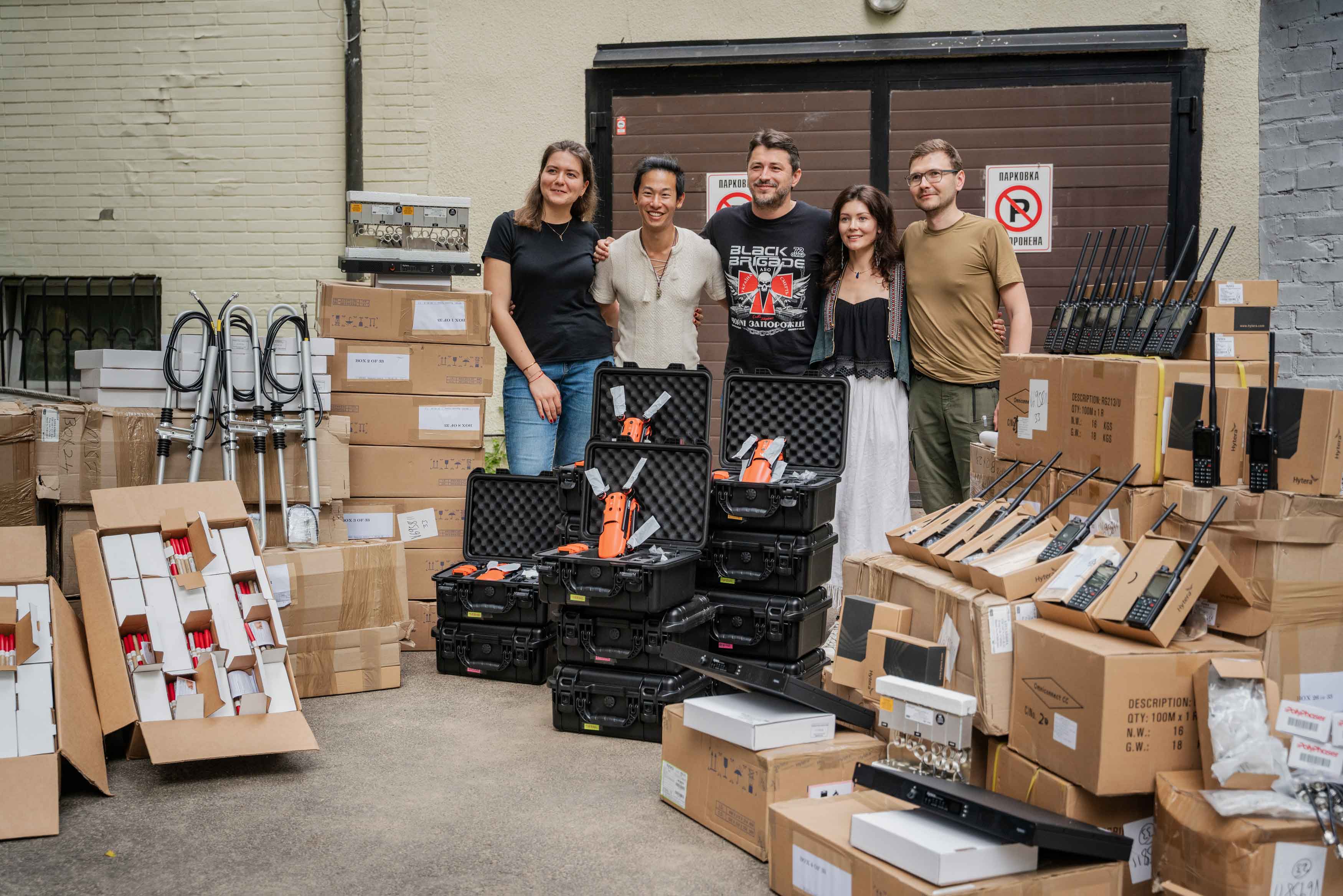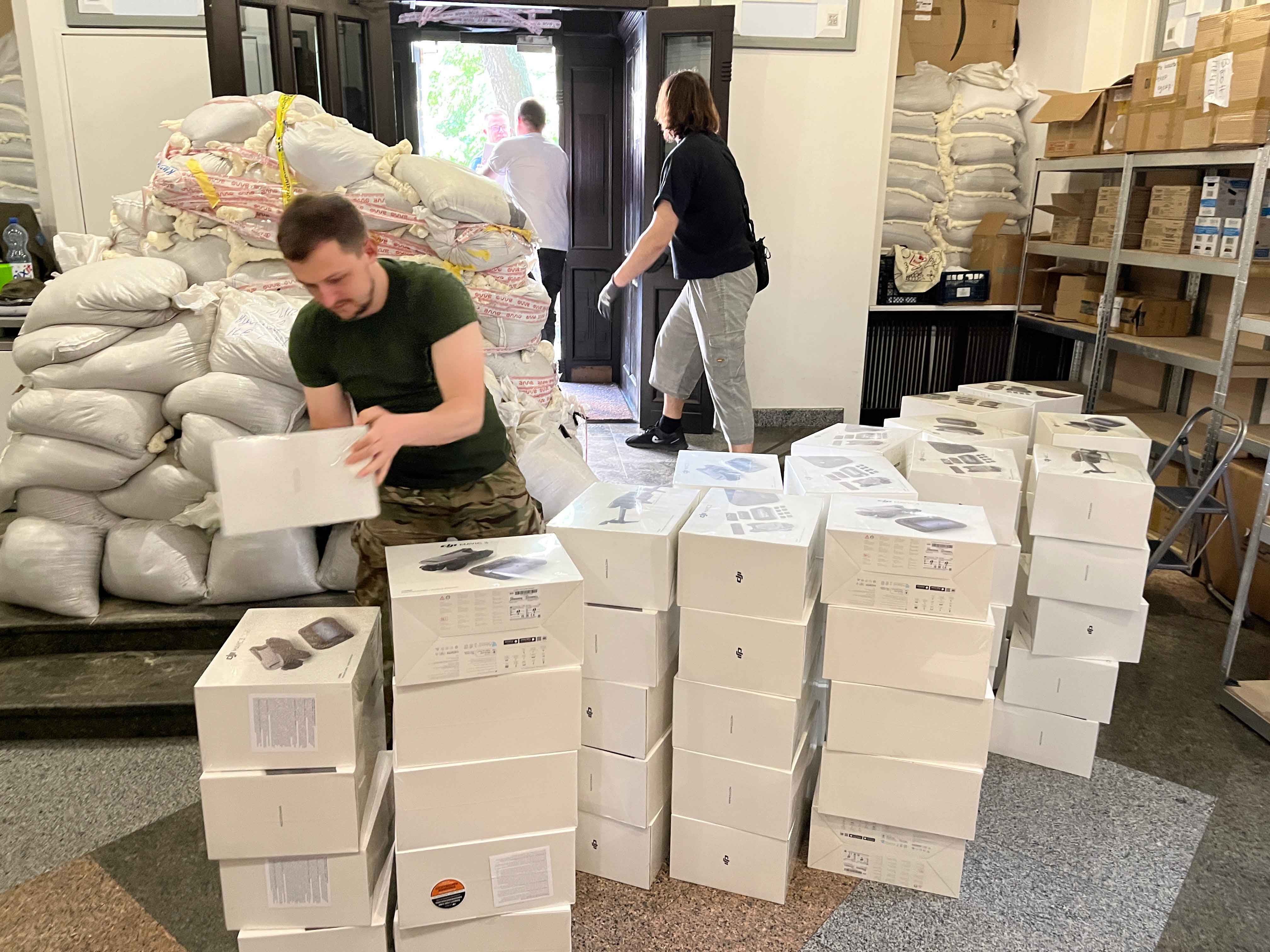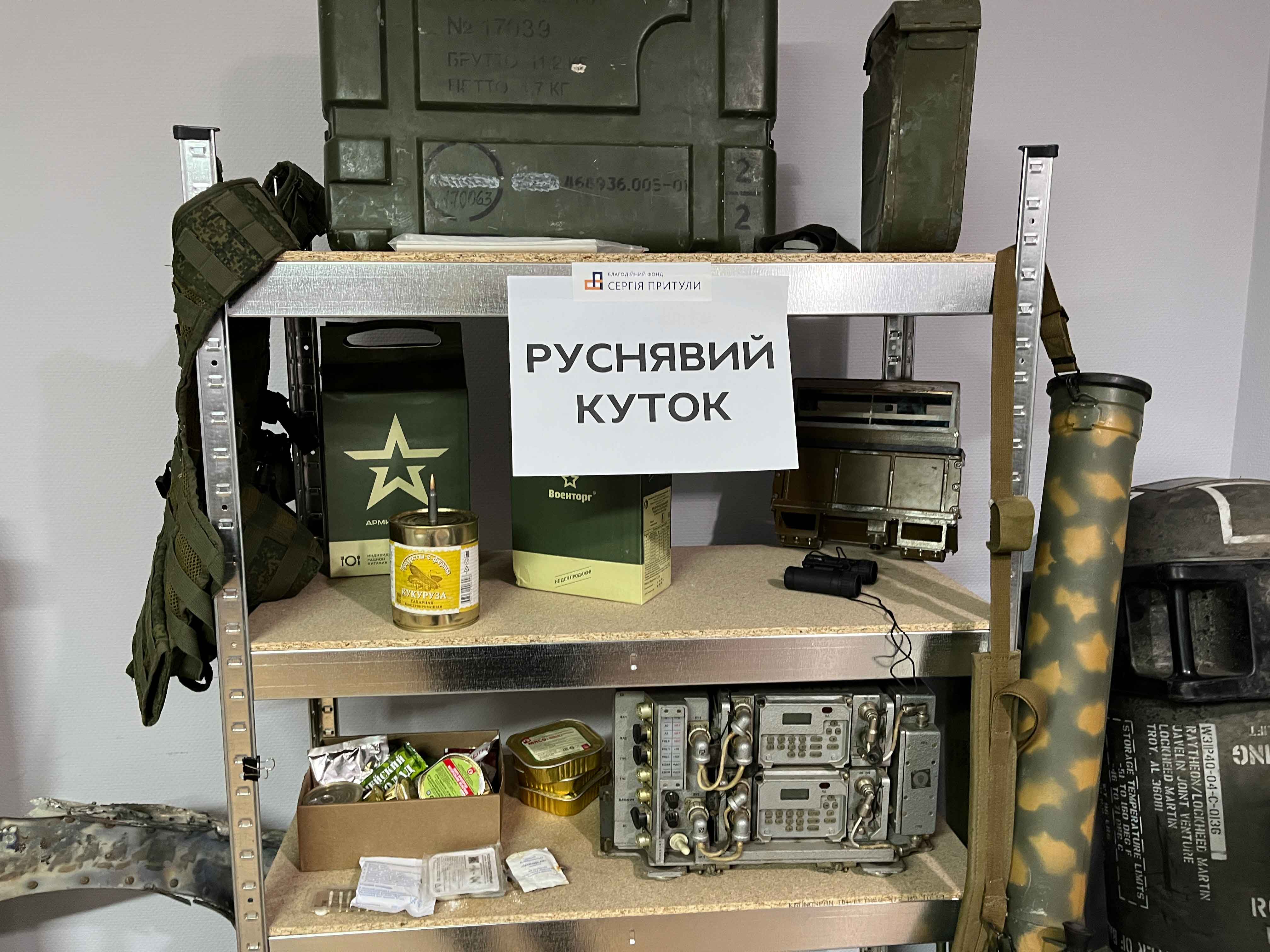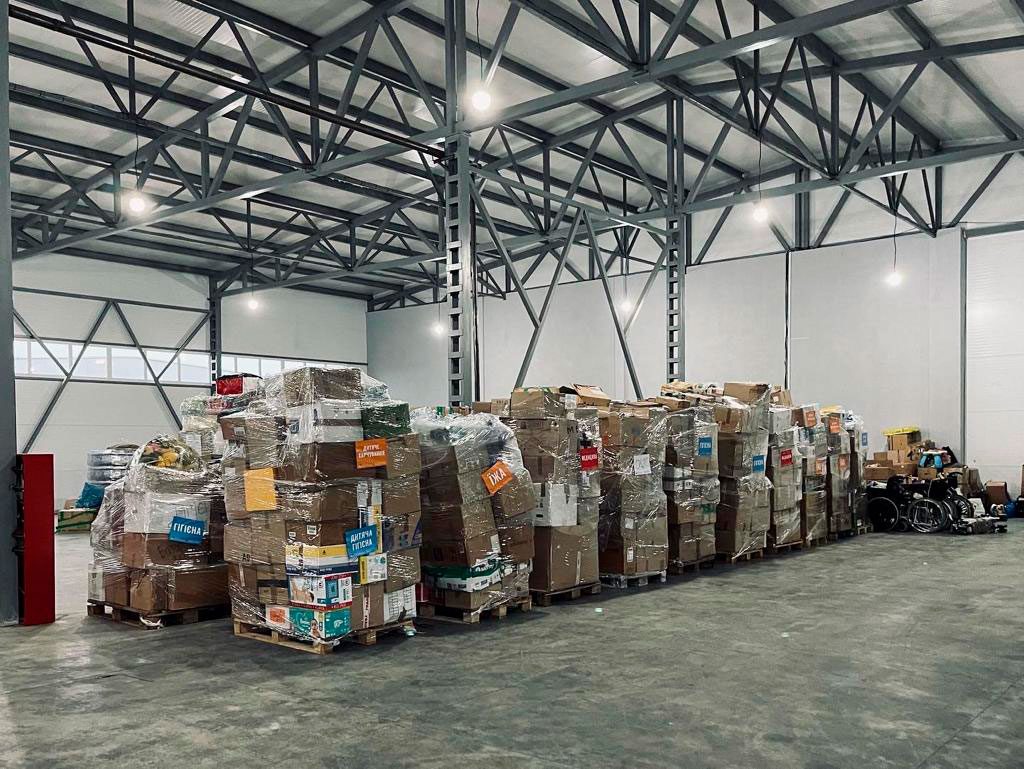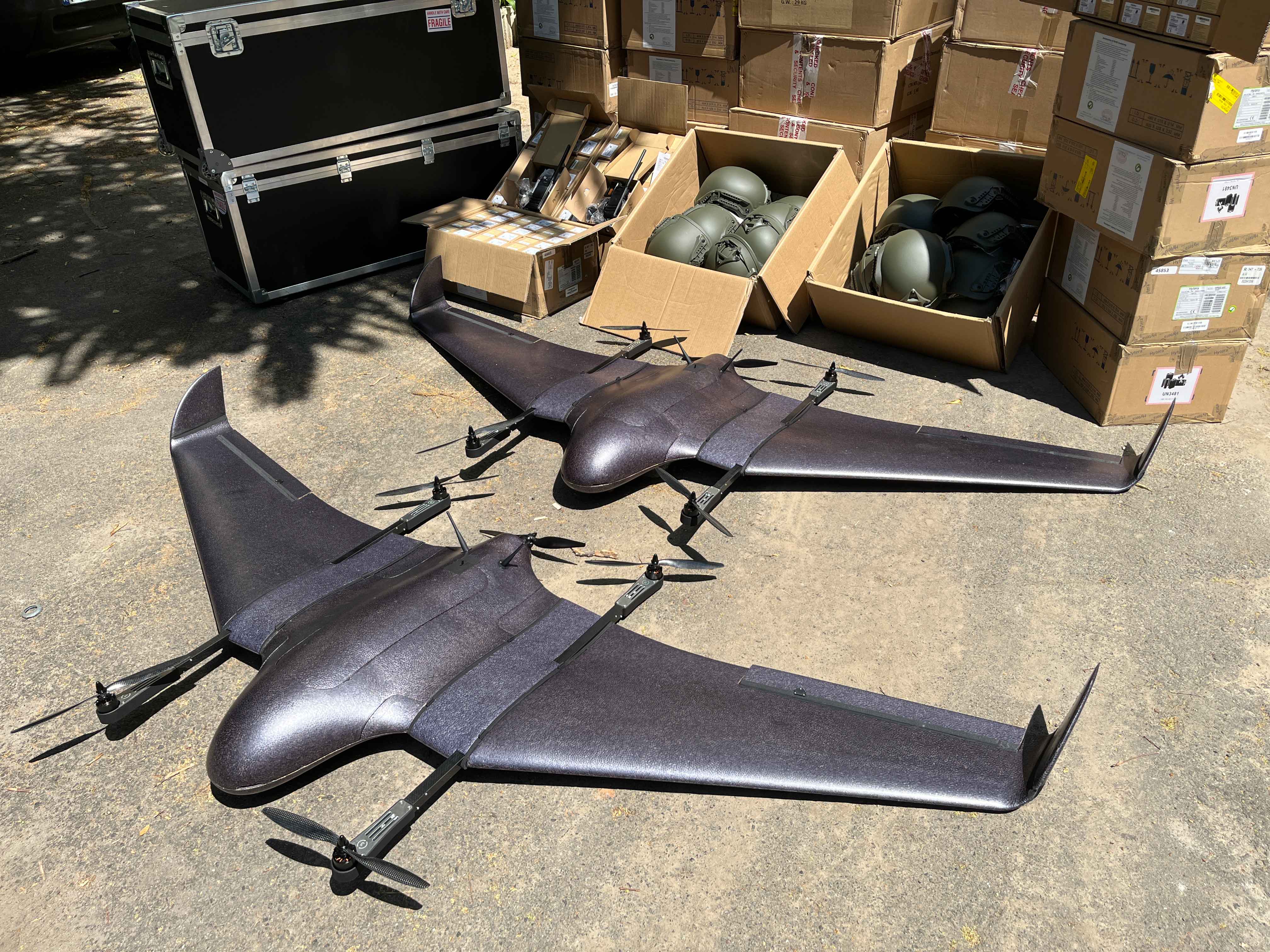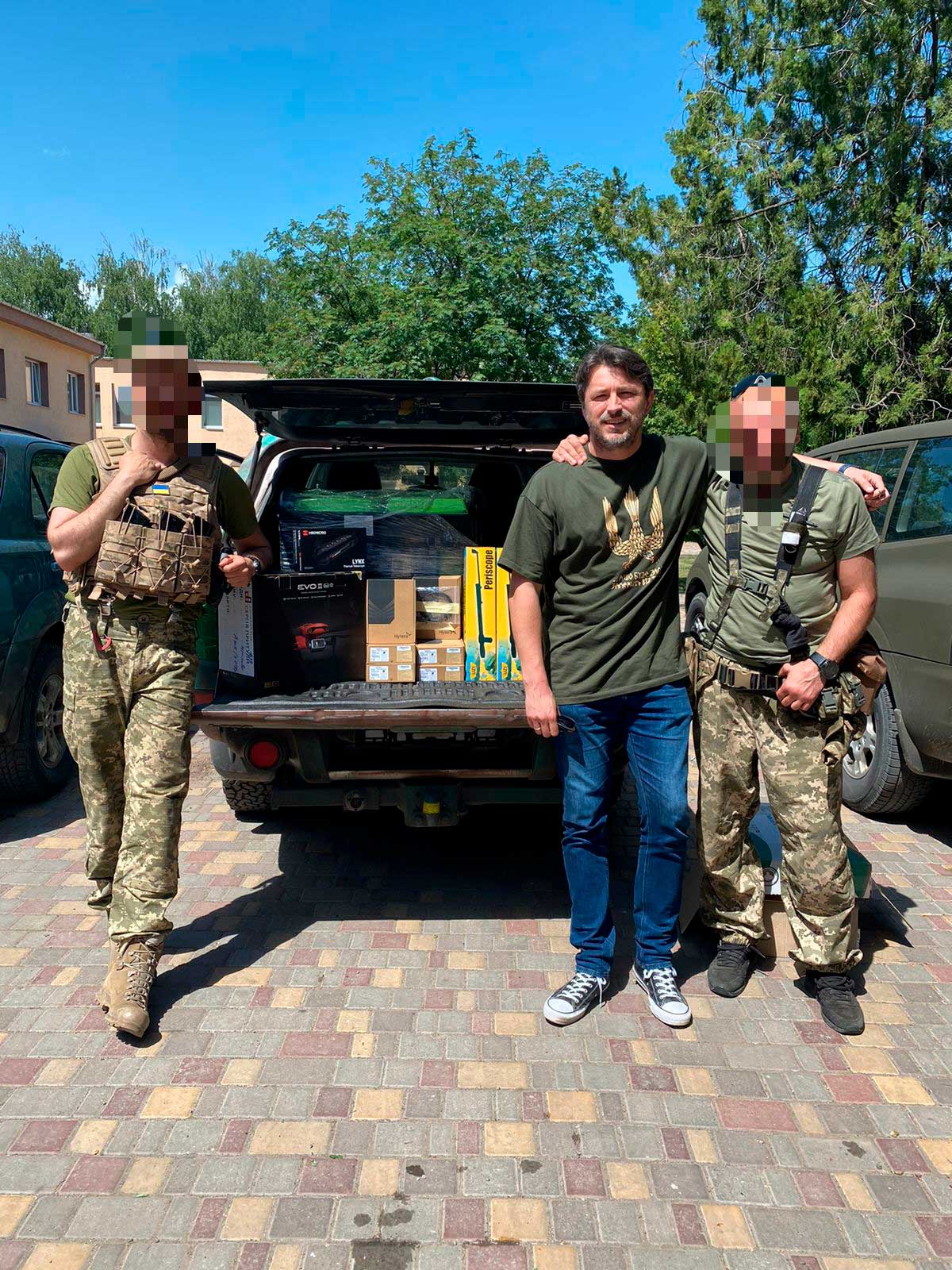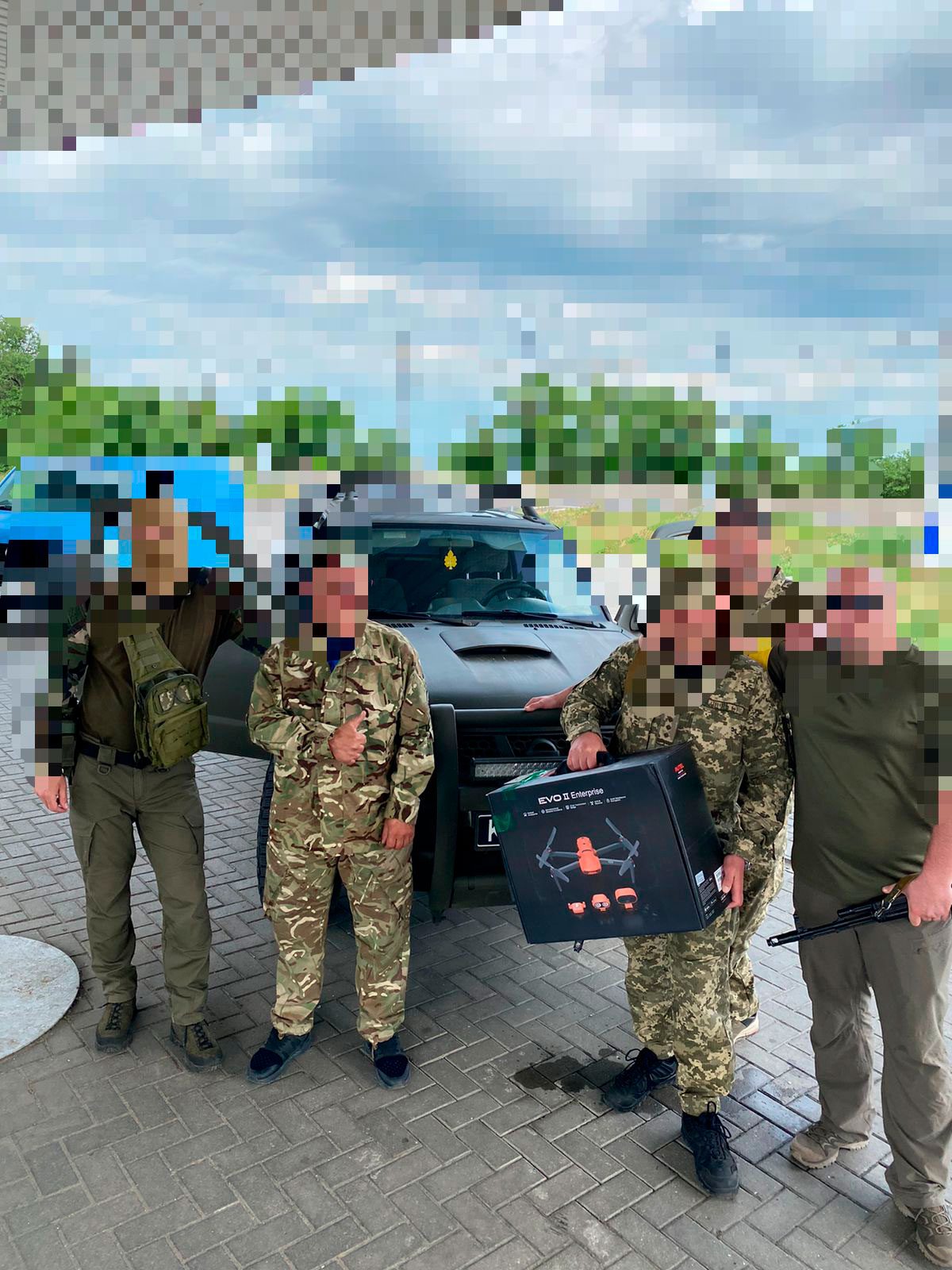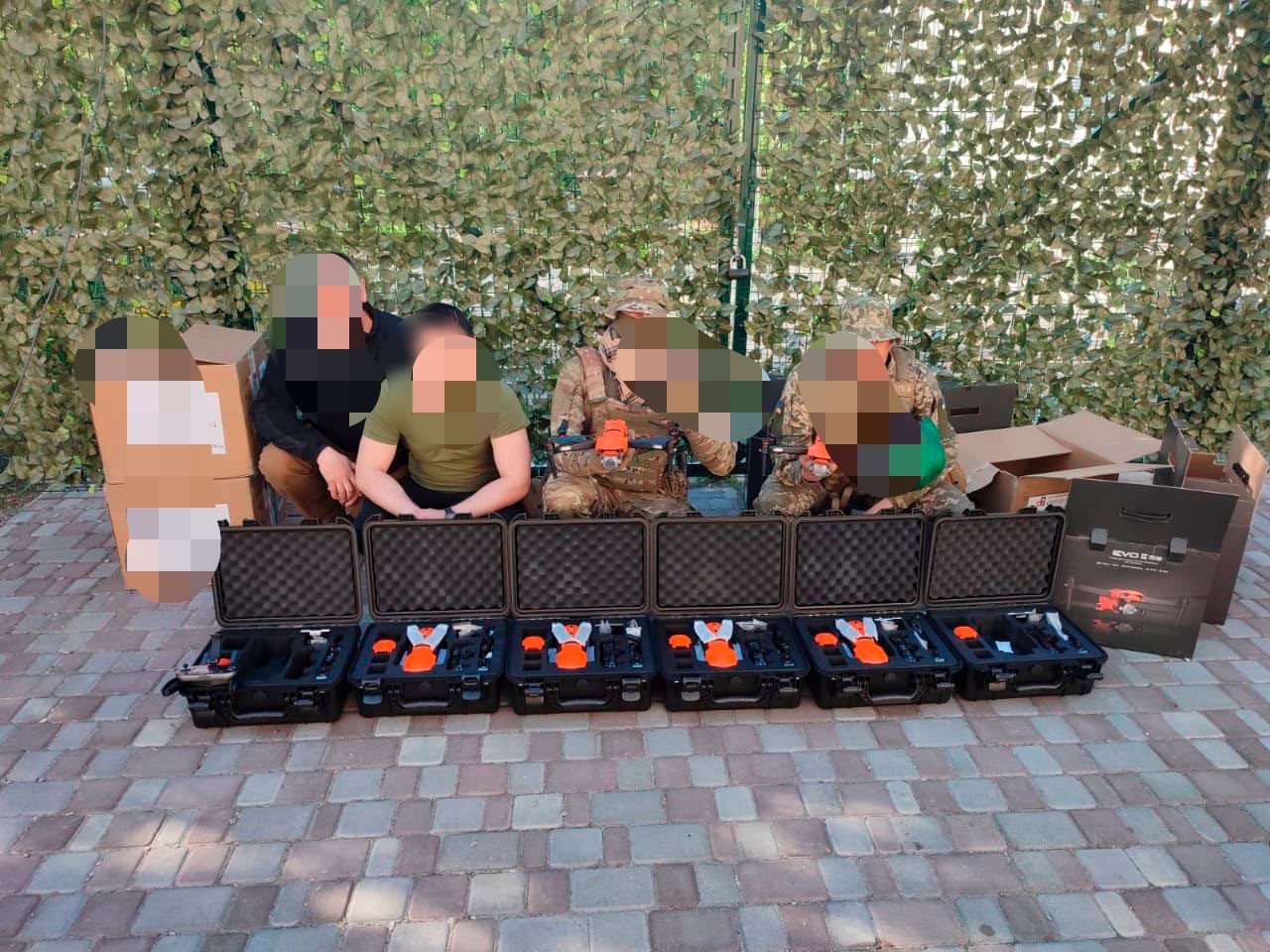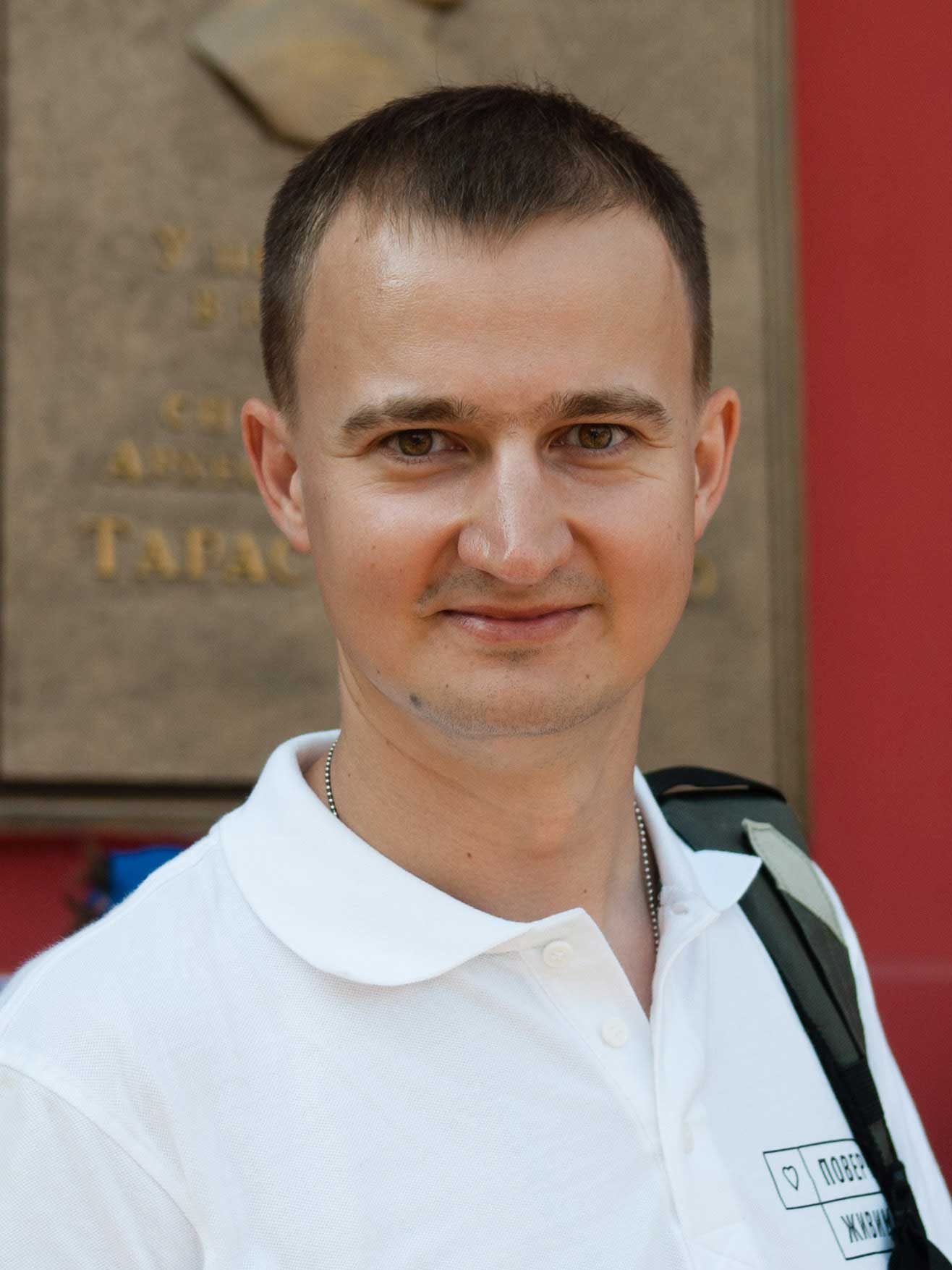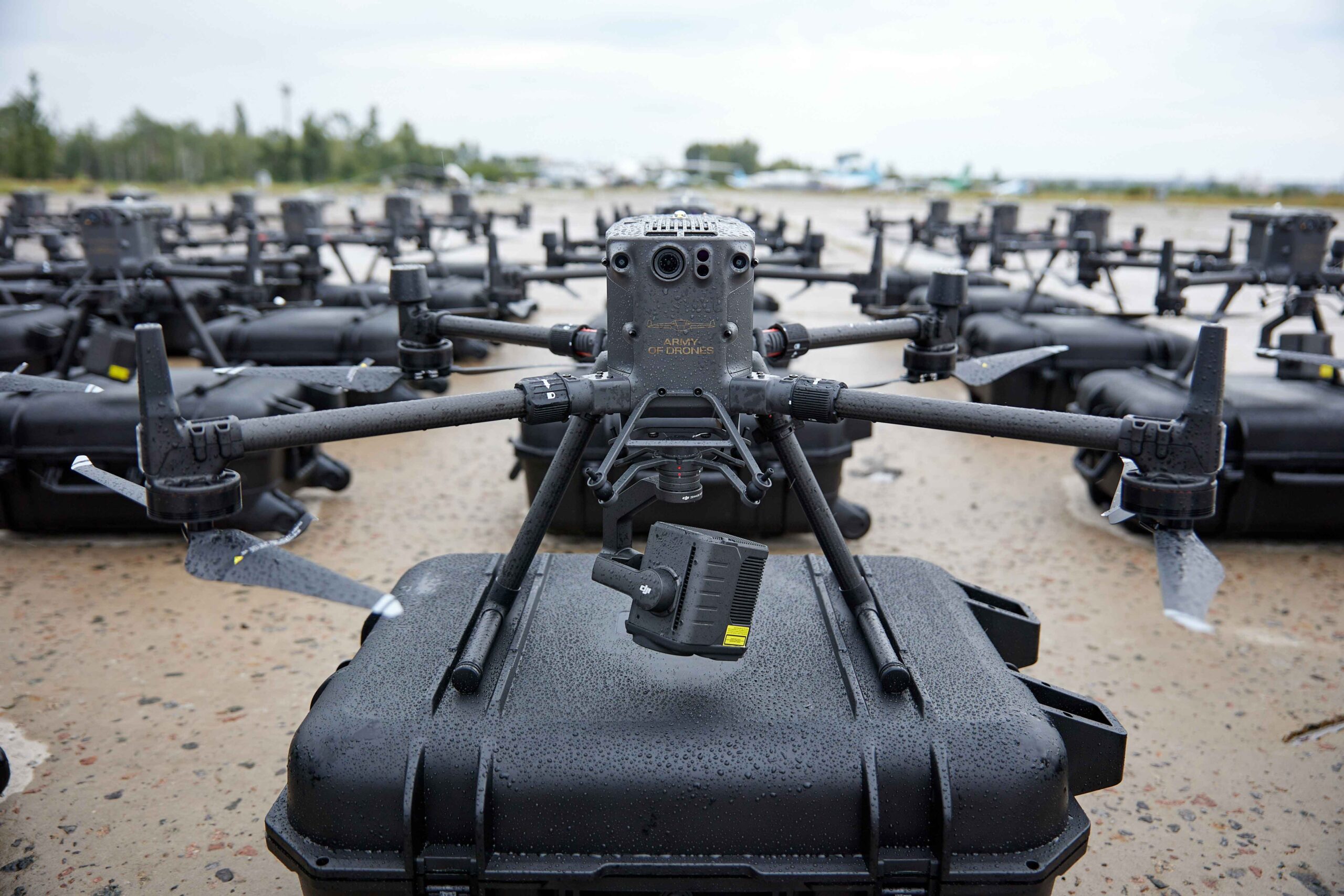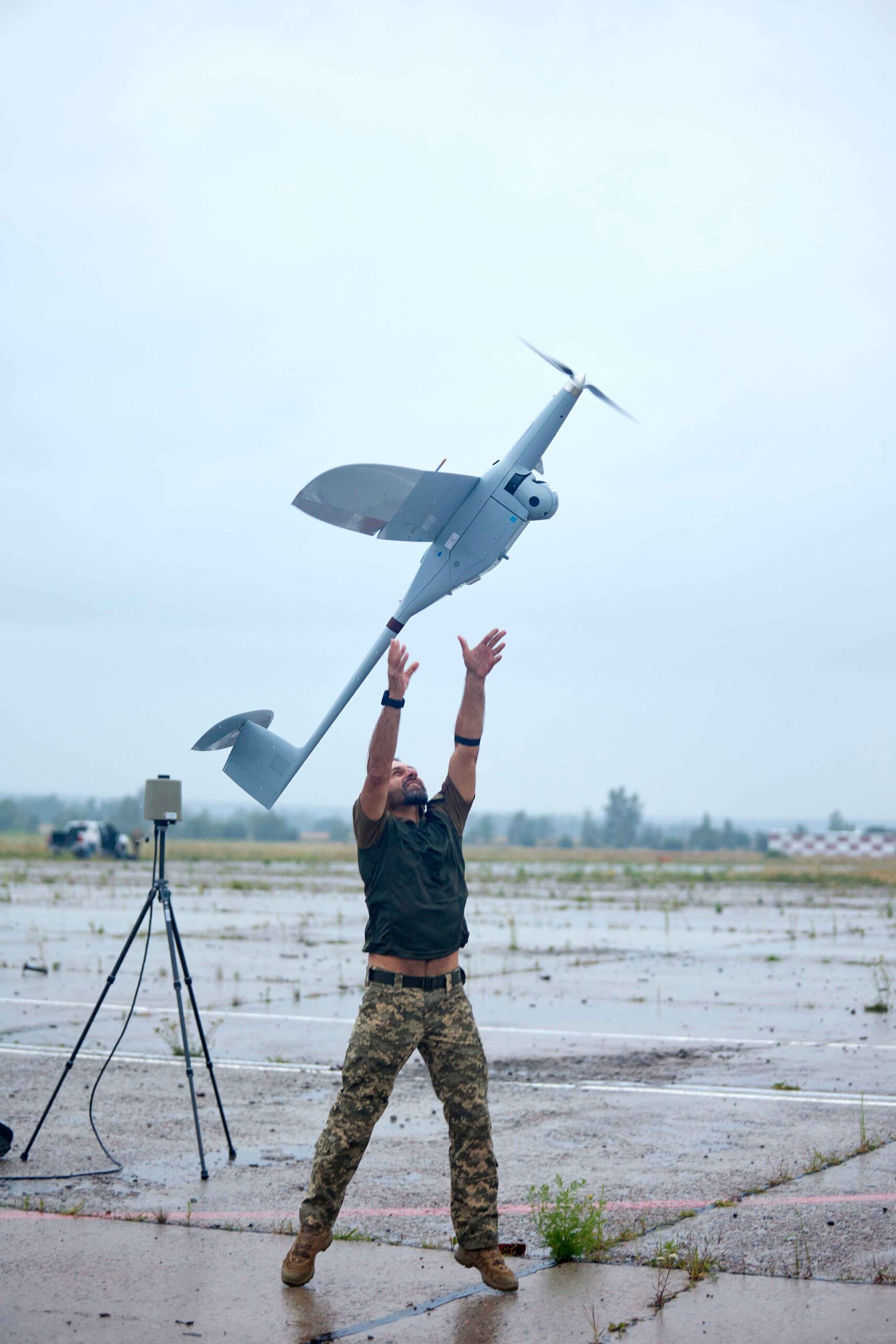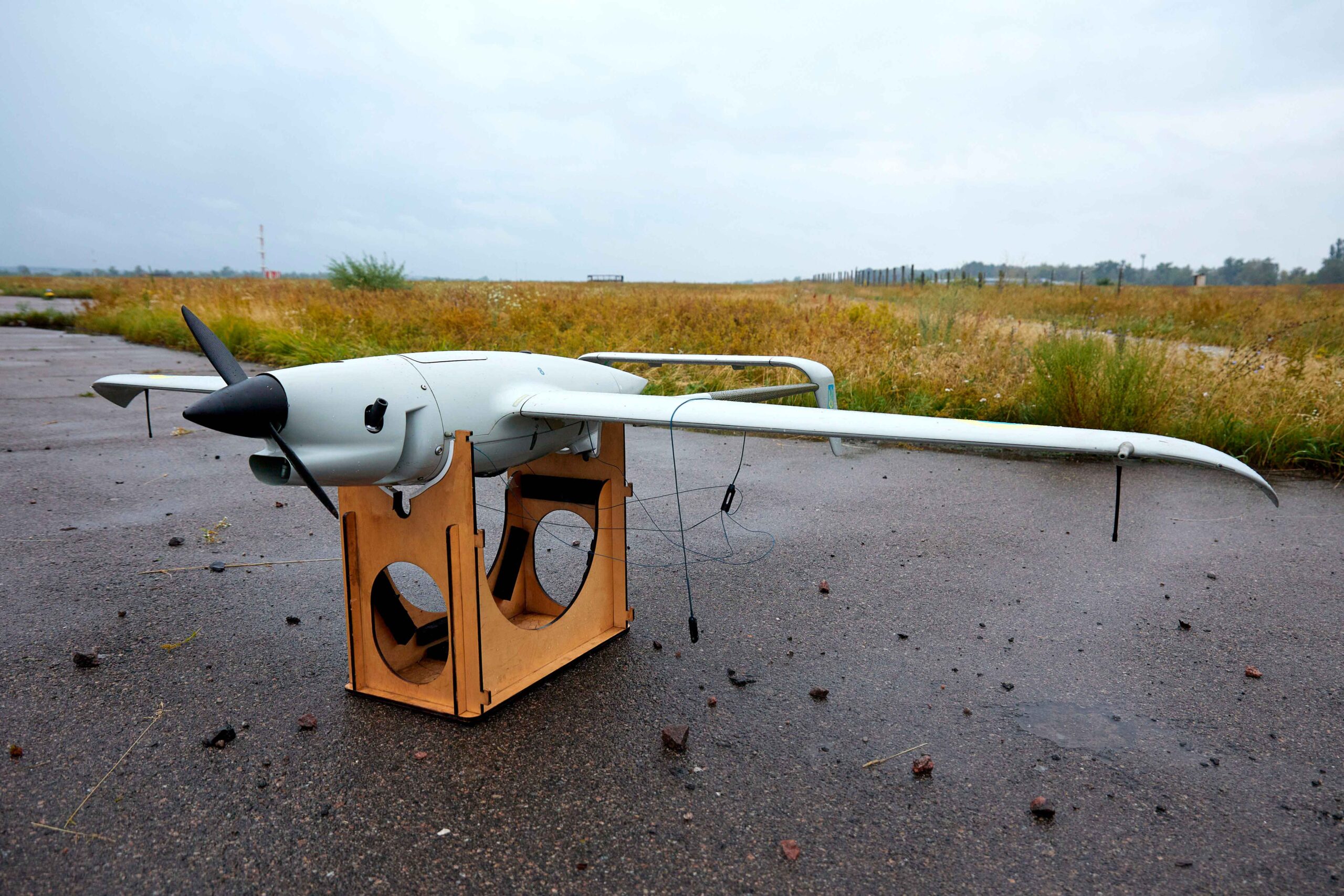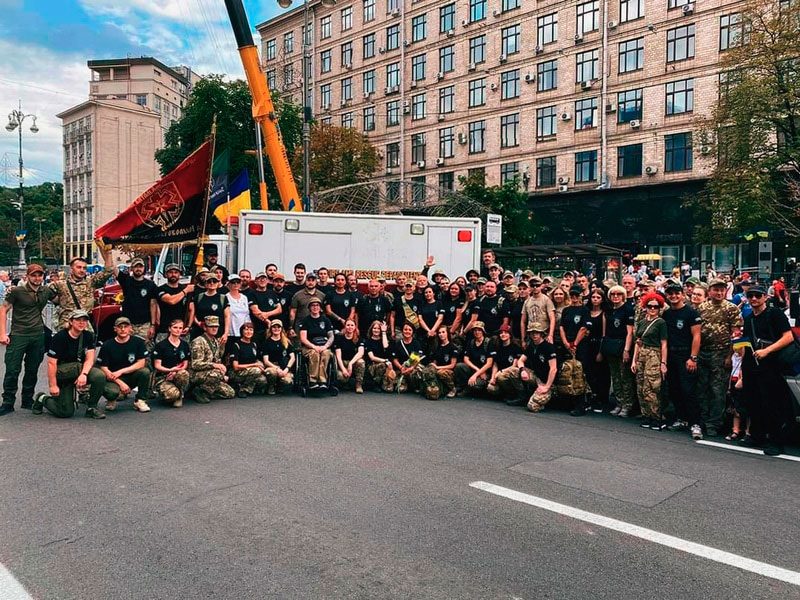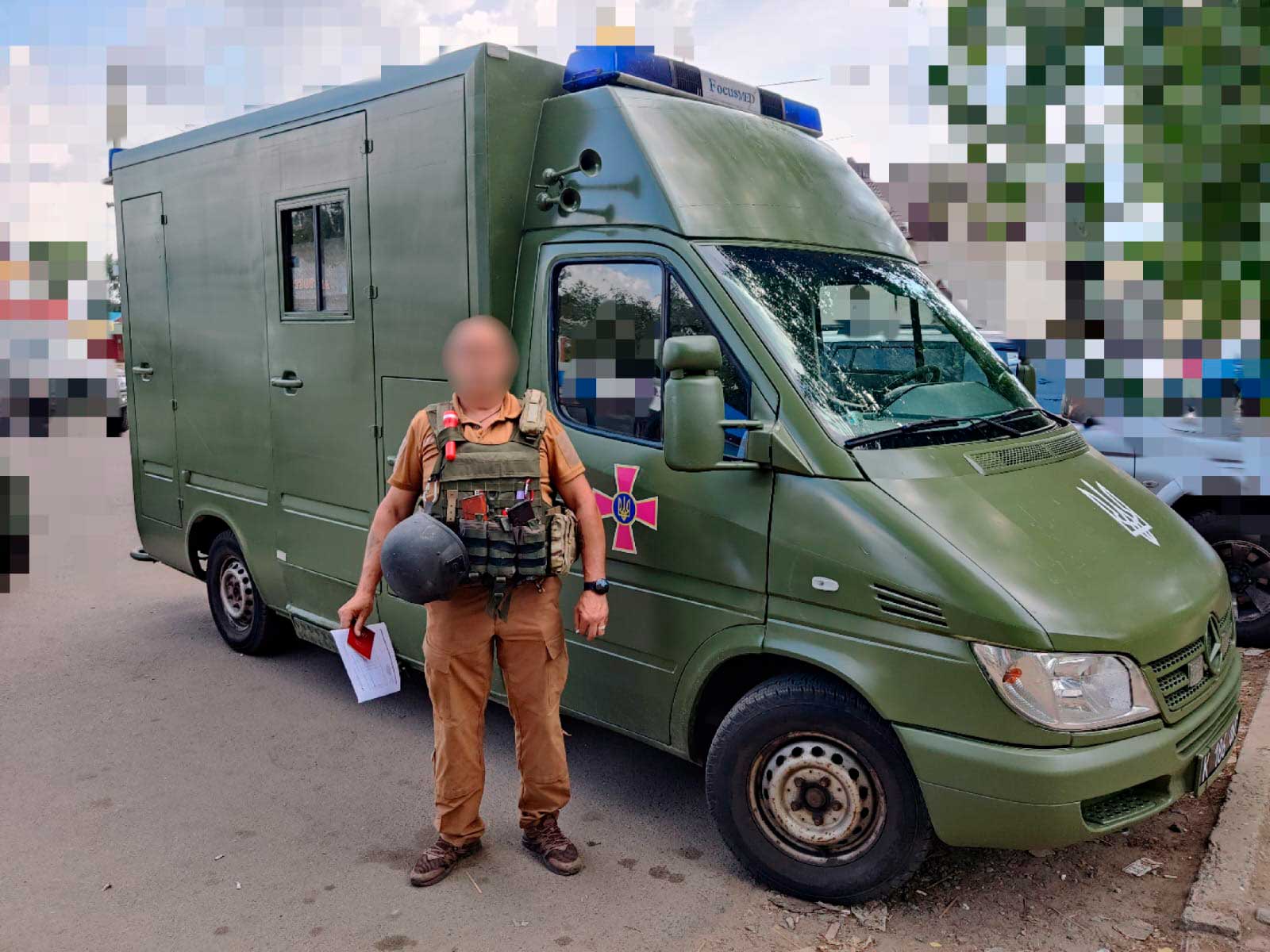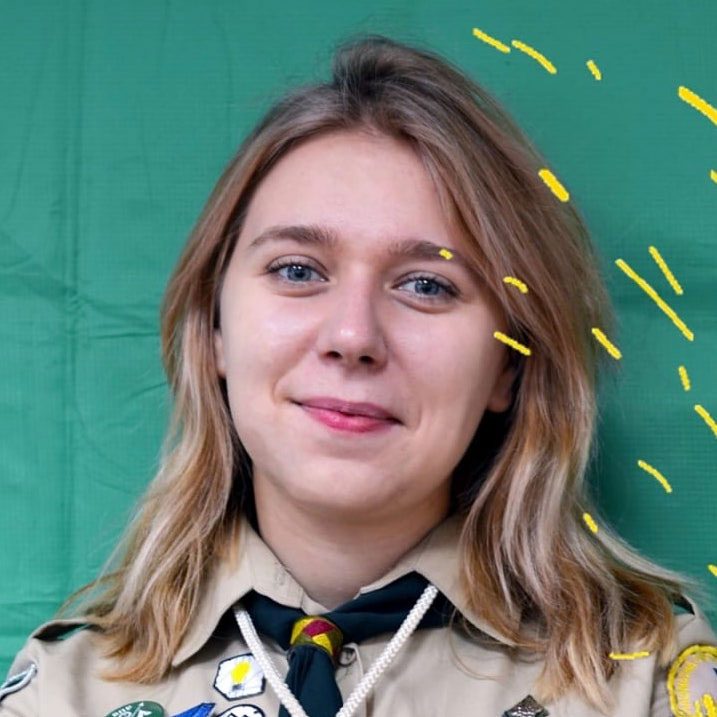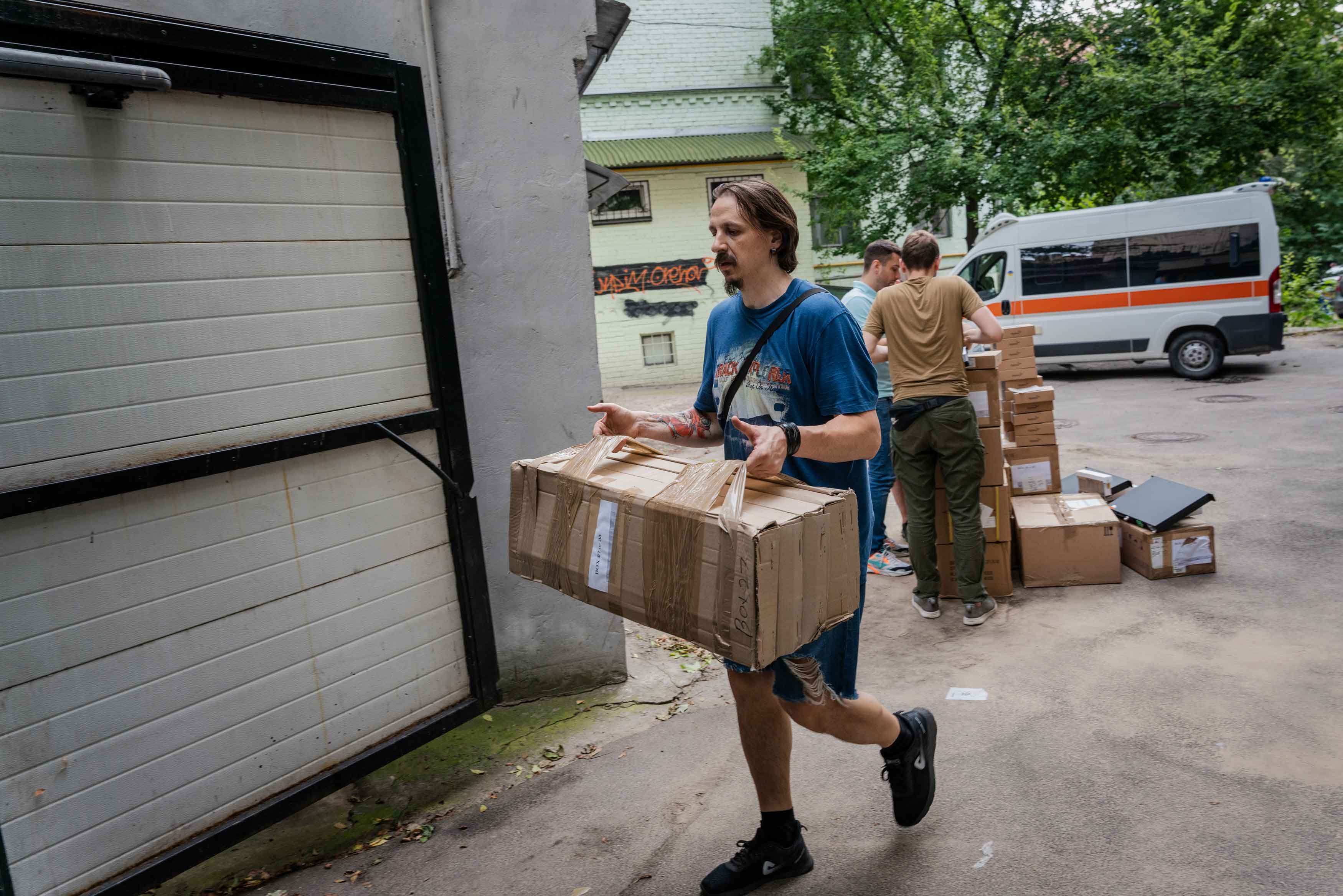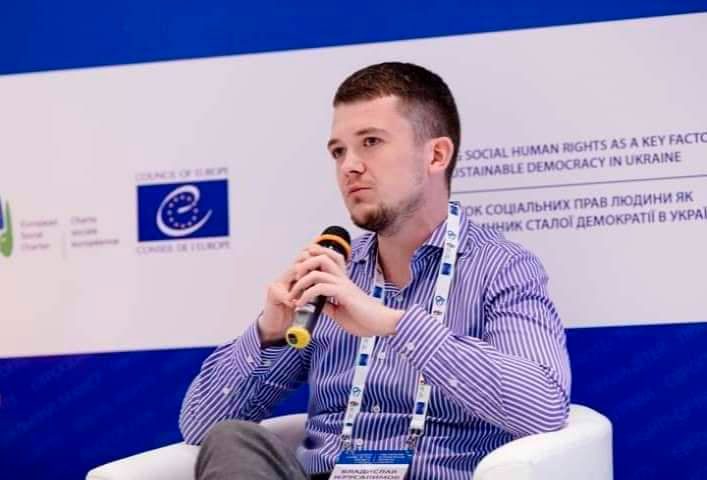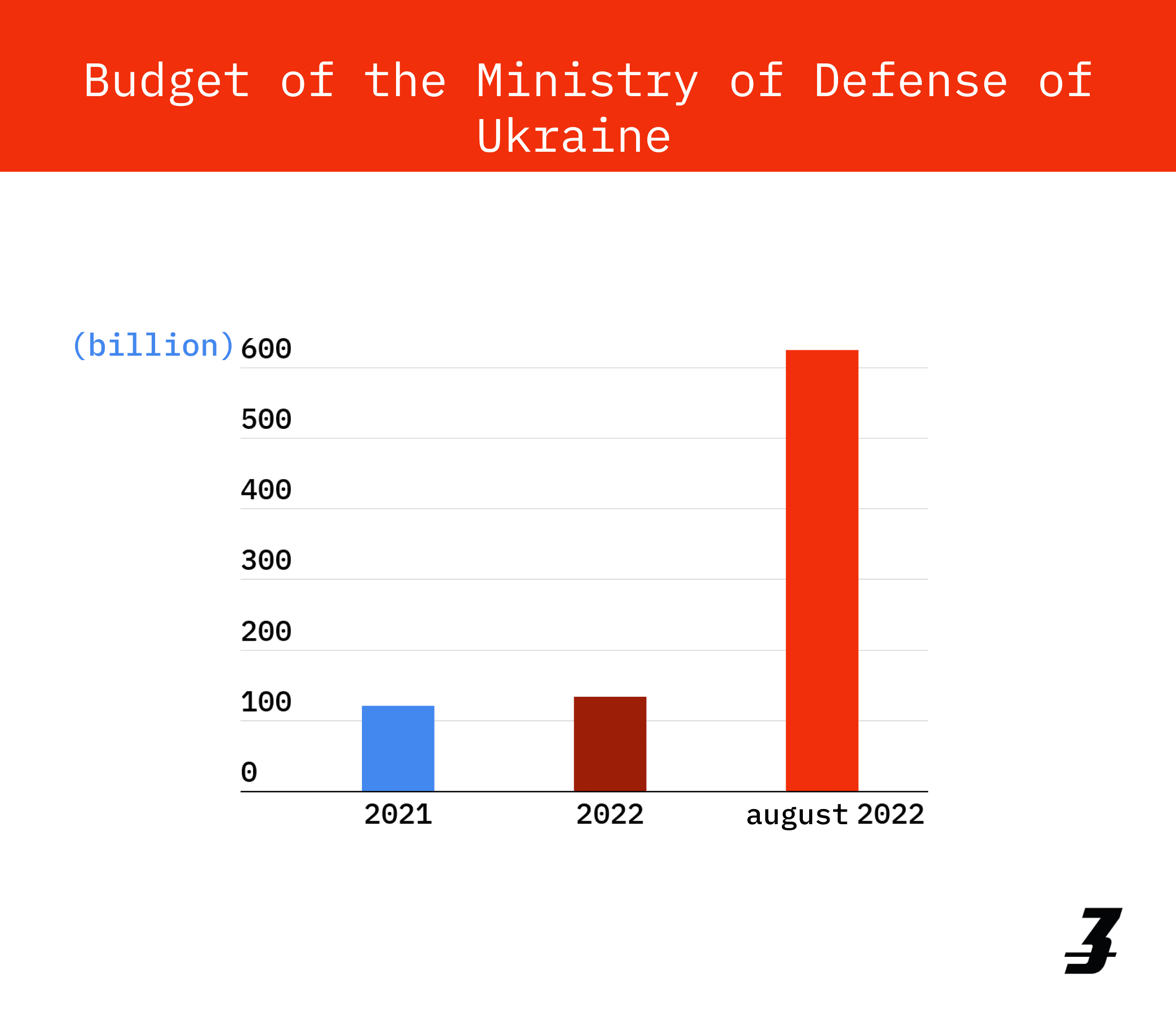Since the beginning of the war in 2014, part of the army’s needs in Ukraine has been covered by volunteers and charitable foundations. After the beginning of the Russian invasion, the number of requests for equipment, weapons, tactical clothing, medical supplies, and cars increased hundreds of times. How do different foundations distribute funds and choose whom to help, do they coordinate with the General Staff and the military command, and why, despite the huge international aid and state funds, do they need donations?
Zaborona journalist Anastasiya Opryshchenko spoke with representatives of Ukrainian large, small, and state funds that collect money for the army. If you donate to the Armed Forces or are looking for advice on which fund to support, this article will answer most of your questions.
Before the start of the Russian invasion, TV presenter and politician Serhiy Prytula helped the Ukrainian army as a private volunteer with equipment, armor, and food, and after the full-scale invasion, he began to provide units with high-precision equipment, drones, and equipment for command posts.

Anna Gvozdiar. Photo courtesy of Maria Pysarenko
In 2020, Prytula created a charity fund for military aid — it was headed by Anna Gvozdiar. From February 2022, the fund began to deal with almost everything: clothing, armor, equipment, and cars.
After the liberation of the Kyiv region from the occupation, the main directions of the fund, says the communications manager of the Prytula Charitable Foundation Maria Pysarenko, became transport, optics, communication, drones, UAVs, and tactical medicine for the military.

Maria Pysarenko, communicator of the Prytula Foundation. Photo courtesy of Maria Pysarenko
The foundation has a humanitarian headquarters that provides assistance to civilians in the occupied territories and within a radius of 70 km from the front line. A separate direction of the headquarters is the NEST project, within which people in de-occupied settlements are provided with free mobile homes.
How does the fund work with the military?
Maria Pysarenko says that at the beginning of the invasion, in February, the military men were coming to the fund’s office on a first-come, first-served basis, and saying what they needed. In a very short time, the volunteers tried to put the necessary things into their hands. Accounting for what was issued to the military, and their verification took place on the spot by volunteers.

Photo report of the fund’s work. Photo provided by Serhiy Prytula Charitable Foundation
According to Pysarenko, the personal contacts of the military volunteer Roman Sinitsyn helped in verifying the requests. Roman coordinates the military direction in the foundation.
“Everything was based on his acquaintances and contacts since 2014. Serhiy Prytula’s contacts also came in handy. Serhiy has known some military personnel since 2014 before they became commanders of battalions or brigades. In this way, verification took place without any papers. There was simply no time for them, although we tried to make a million tables,” says Maria Pysarenko.

Photo report of the fund’s work. Photo provided by Serhiy Prytula Charitable Foundation
Initially, the Prytula Foundation received many calls to hotlines from relatives of the military with individual requests. But it was difficult to enter and process them, so the fund started working not with individual requests, but at the level of battalions and brigades. Now, in response to the request, the foundation asks to send a letter from the unit commander with confirmation and details of the contact person for verification.

Photo report of the fund’s work. Photo provided by Serhiy Prytula Charitable Foundation
How does the foundation decide what to buy for the army?
Pysarenko explains: the Prytula fund works with the requests of the military, which are often coordinated with the battalion command. That is, the military turn to the battalion commanders with their requests, and they, for their part, form a list of what is needed.
Then the foundation holds meetings with the command of the Support Forces of the Armed Forces of Ukraine — and in this way checks how relevant these or other requests are, after which it fulfills them. In addition, the fund tries not to overlap in purchases with other funds or the Ministry of Defense, and also not to limit itself to one and the same Ukrainian manufacturer.
“We don’t buy what we suddenly decided to buy ourselves. All these requests are coordinated with the military who are on the front lines and with whom our volunteers communicate. We work in conjunction [with the military command], that is, there is no such thing as requests coming from nowhere and we buy it. Or, as was in the case with the satellite, we immediately came to the Ministry of Defense,” the communicator assures.
According to what priority does the fund help the military?
First of all, the fund helps those soldiers who are closest to the combat zone.
“Our volunteers are in constant contact with the military, communicate every day, and know where and what is needed. And taking into account internal knowledge, applications are adjusted. We understand that we cannot cover everyone’s needs. There are those who are offended. But, for example, some applications are not relevant to us in the sense that the state is already fully taking care of them — such as bulletproof vests. And we don’t deal with sappers’ applications, simply because there is nothing to help,” says Maria Pisarenko.

Photo report of the fund’s work. Photo provided by Serhiy Prytula Charitable Foundation 
Photo report of the fund’s work. Photo provided by Serhiy Prytula Charitable Foundation

Photo report of the fund’s work. Photo provided by Serhiy Prytula Charitable Foundation
Is it possible to fulfill all requests?
If the foundation receives a request that it cannot fulfill, because it does not deal in this area, volunteers simply close the application.
“Usually, we do not forward such applications to other volunteers because we cannot vouch for other organizations,” the foundation notes. “And if we continue to forward applications, then there will be twice as much different work. This is a separate direction. But we are doing our best to fulfill the maximum number of requests given the resource we have.”

Photo report of the fund’s work. Photo provided by Serhiy Prytula Charitable Foundation
Pysarenko explains: if the fund currently does not have the necessary equipment, the request of the military is put on a waiting list. As soon as the item appears, the military gets it. In general, the foundation prefers urgent applications, when volunteers know for sure that a soldier is or will soon be fighting “at ground zero” (on the front line). Pysarenko recalls that when Severodonetsk was being defended, volunteers took dozens of drones there almost every day.

Photo report of the fund’s work. Photo provided by Serhiy Prytula Charitable Foundation
“There is no such thing as drones just lying around and we hand them out. In fact, the demand is so great that people are constantly queuing. And even if a new, recently created unit applies, there is almost a 98% probability that our volunteers already know about it — or will know about it. And if they know that it was created specifically and urgently, then their requests will be put as a priority, even higher than those who ordered earlier and were in the queue for a conditional month,” Maria Pysarenko emphasizes.
What does the Come Back Alive Fund purchase?
One of the largest charitable foundations that help the military is Come Back Alive. Since 2014, the fund has been purchasing thermal imaging optics, quadcopters, cars, protection, and intelligence systems. The foundation has instructors responsible for training sappers, unmanned aerial vehicle (UAV) operators, gunners, and snipers, and also teaches first aid.
Maksym Zinchuk, project manager of the Come Back Alive, in a conversation with Zaborona, notes that volunteers do not deal with ammunition such as unloading vests and pouches, clothing, or food. The fund takes care of medicines and medical equipment only if they are handed over to volunteers — they do not buy anything themselves.

Maksym Zinchuk, project manager of the Come Back Alive. Photo courtesy of Maxim
In the spring, the fund received permission to purchase military goods, that is, weapons. Now it buys not only a certain type of optics and communication but also the means of “active destruction” that are in service in the US army and other advanced European countries.
“At the end of March, the fund received permission from the State Export Control Service of Ukraine to purchase goods for dual and military purposes. Now we can directly, without intermediaries, buy the necessary goods from manufacturers. Thus, Come Back Alive speeds up work and eliminates corruption risks. It also enables the fund to independently control the supply of weapons and determine to whom to assist,” Maksym Zinchuk explains.
How does the Come Back Alive fund work with the military?
Volunteers and instructors of the foundation have been working since 2014 and have contacts with many departments. Thanks to personal acquaintances and their own experience, they know where to give help first. In a conversation with Zaborona, Zinchuk explains that the fund primarily helps those military units that take part in hostilities.

Taras Chmut, head of the Come Back Alive Foundation. Photo: Wikimedia
In general, Come Back Alive works with battalion commanders through applications that military personnel can fill out on the website. In March, almost any military man could do it, but then the fund structured its work and, like the Serhiy Prytula fund, switched to large requests.
“Now we try to accept applications for assistance at the level of brigades. Less often — at the level of battalions. Soldiers coordinate the list of necessary items with the commander and collect the needs not only of the company but also of their own and other battalions. All this turns into a joint application that goes to our specialists. The list is checked and approved. There are cases when we offer the military to expand the application — for example, to add equipment to copters or increase their number. However, there are also refusals. In addition, we divide requests into priority and secondary requests,” says Zinchuk.
Maksym also emphasizes that they provide assistance to those military personnel who know how to handle the equipment. At the same time, the foundation trains people to work with the equipment and then provides the necessary.
How does the fund decide what to purchase for the Armed Forces?
According to Zinchuk, Come Back Alive works directly with military units and command to know what is best to buy. The fund has access to the commander-in-chief, and can coordinate something with the Ministry of Defense, but does not report to the state on its purchases.
“We have a military department that deals, in particular, with collecting and processing applications from army personnel. Since the foundation has information about the situation at the front, we can predict exactly what the military will need. Communication, laptops, tablets, drones are always needed, for example. And some specific things are purchased for specific tasks, not only for the Armed Forces but also for other state security services. In fact, the fund itself decides what to purchase, according to the information that our colleagues received directly from the military,” says Zinchuk.
Are there government assistance programs for the military?
Since the beginning of the full-scale invasion of Ukraine, many fundraising platforms have been launched to help raise funds for the Armed Forces. For example, in the summer, on the initiative of President Volodymyr Zelensky, the United24 fundraising platform was launched. Its task is to become the main window for collecting funds to support Ukraine. Donations can be made for defense and demining, medical aid, and reconstruction of Ukraine.
Within United24 the General Staff of the Armed Forces of Ukraine and the Ministry of Digital Information announced the launch of the «Army of Drones» project. This is a comprehensive program that includes the systematic purchase of drones, their repair, and operational replacement, as well as a pilot training course. In addition, people can donate their own drones and quadcopters.

DJI Matrice drones. Photo provided by United24 team
The Minister of Digital Transformation, Mykhailo Fedorov, in his comments to Zaborona, says that from the beginning of the development of the project concept to its implementation, the ministry cooperated with the military.
“The General Staff of the Armed Forces of Ukraine helped us qualitatively analyze the military’s needs for drones: types, number, in which areas of the front they should work. The Ministry of Digital Transformation provides overall coordination of the Army of Drones project. Purchases take place according to the procedure established by state bodies. All funds donated by people from all over the world through United24 go to a special account of the Ministry of Defense at the National Bank. Purchases are made from this account,” explains Mykhailo Fedorov.
Who from the military will receive drones and which ones?
Mykhailo Fedorov tells Zaborona that the Ministry of Digital Transformation will communicate publicly with the brigades for the transfer of drones, and if there is permission from these brigades, it will inform about them in general.
As for what kind of drones are needed in the army, the minister notes: now the front is conventionally divided into four levels. The first line is up to 3 km, the second, third and fourth – up to 25, 50, and 200 km, respectively. Commercial and civilian drones are essential for urban warfare and short-range reconnaissance. For such needs, it is planned to transfer drones donated by people themselves.

Fly Eye drones. Photo provided by United24 team
“Other lines require large drones that fly long distances. In the first stage, we prioritized buying 200 professional unmanned aerial systems of the tactical level for aerial reconnaissance. And we have already achieved this goal. But our task is to constantly maintain this number of drones at the front because some of them are destroyed by the enemy. The speed of repairing the drone depends on the nature of its damage, the availability of the necessary parts, and the workload of the service. On average, it is about 5-7 days,” says the minister.
As of August 29, within the framework of the Army of Drones project, contracts for almost UAH 948 million have been agreed upon, that is, for 877 drones. First of all, these are UkrJet, Skyeton, Fly Eye, Warmate, SKIF, DJI Matrice RTK 300, DJI Mavic 3, and Autel Evo 2 drones. The Minister of Digital Transformation explains that they cannot reveal all the suppliers and the names of the companies with which contracts have been concluded. However, he notes that the state works with both international and Ukrainian companies. Among Ukrainian manufacturers, he mentions SKIF, Skyeton, and Ukrjet.

Skyeton drone. Photo provided by United24 team
What is the experience of the military in working with funds?
Zaborona spoke with a military man stationed near the northeastern border with Russia in the war zone. Anton (name changed) said that the volunteers helped him personally and his unit separately.
“For my unit, I tried to find a lot of things, there were big requests that I couldn’t fulfill. We needed a car, a good thermal imager, and digital radios. I applied to a fairly large fund, but, unfortunately, they simply ignored us,” says the soldier.
Anton adds that the military from his unit turned to the command and then, if possible, commanders found what they needed. However, for the moment, Anton’s battalion was temporarily transferred to another brigade — in fact, they formed two leaderships. “Our needs are often transferred to our native brigade, and not to the one we are in now. It turns out that we have two commanders and one ship, so it is not possible to steer the supply normally,” the fighter notes.
In the end, Anton’s request for a unit was partially fulfilled by friends, collecting walkie-talkies and other necessities through Instagram. The military man says that his comrades from the unit also covered common needs through friends and acquaintances, and not through large funds.
“Thanks to friends and acquaintances, we got two cars. From my experience, I understood this: large foundations cooperate immediately with the command of the battalion (because I know for sure that our battalion received a drone from the Prytula Foundation). But when you are looking for something necessary as a unit, and not as a battalion, it is easier to turn to friends and acquaintances or buy at your own expense. Although I heard that it was necessary to find a patron who would deal with closing our needs, but, honestly, I have no idea how to do it,” says the soldier.
Local funds
In addition to the large funds that help the Ukrainian military, there are also smaller ones that arose on the basis of public organizations or battalions. For example, Hospitallers is a Ukrainian volunteer medical battalion that has been participating in the armed conflict in Ukraine since 2014, providing first aid and evacuating wounded soldiers of the Armed Forces of Ukraine from the combat zone. The Hospitallers fund itself was created in June of this year.

Hospitallers Fund. Photo: hospitallers.life
In a conversation with Zaborona, representatives of Hospitallers briefly explained that the organization was founded primarily to make it easier to work with other organizations that provide assistance to the battalion. Whenever possible, the volunteers of the foundation share what is more expedient to transfer to someone (for example, equipment that is currently needed in hospitals). But in fact, the fund focuses exclusively on its battalion and gives it everything it needs.

Photo report of the fund’s work. Photo provided by Serhiy Prytula Charitable Foundation
The NGO Plast — a Ukrainian scouting organization — works according to the same principle. The purpose of Plast is to promote patriotic education and self-education of Ukrainian youth. Plast in Ukraine unites up to 10,000 members of various ages and thus is the largest scouting organization in the country.
Ksenia Dremlyuzhenko, the head of the military department of the Plast, says that many Plast soldiers joined the ranks of the Armed Forces of Ukraine back in 2014. On February 24, a charitable fund was created at the Plast base, which tries to help, first of all, its students and teachers who went to war. The main direction of the fund is the support of platoon soldiers and the brigades in which they serve.

Ksenia Dremlyuzhenko, the head of the military department of the Plast.
Photo courtesy of Ksenia
“At the beginning of the invasion, we realized that we had to create a separate direction to support the military. Many brigades lacked basic things. First of all, we wanted to save the lives of the plastuns, our educators.
Previously, they worked with children every week — and we must protect them so that, when peace comes, they continue to educate the patriotic future generation of Ukraine,” Ksenia explains in a conversation with Zaborona.

Photo report of the fund’s work. Photo provided by Serhiy Prytula Charitable Foundation
Who does the fund help and in what areas?
Although Plast is not very large, it provides for the individual needs of the military. In general, the foundation deals with food, clothing and shoes, tactical medicine, and 32% of the donations collected by the foundation go to helmets, armor, and gas masks for the military. Plast also provides humanitarian assistance in some cities. The fund reports all expenses and income on its page.
The foundation does not cooperate with government organizations but consults about the purchase of equipment or other things through its familiar military personnel.
“We help not only our members, plastuns,” says Dremlyuzhenko. “For example, the Plast headquarters in Lviv and Zhytomyr took care of the brigades in their cities and cover their needs. The Ukrainian diaspora in other countries helps to raise funds. We also have patrons and benefactors who share our values and therefore help us. Well, we don’t rule out volunteer fundraising, when volunteers collect money for drones, night vision devices, uniforms, walkie-talkies, clothes, or some basic things through posts on social networks.
How do you work with requests and do you fulfill all of them?
At the beginning of the invasion, Plast, like other volunteer organizations, was able to close more requests and even buy cars. Now the fund focuses on what exactly the brigade or the military needs and what they can provide. If the resource is not available, the foundation looks for other volunteers to help meet the military’s request.
At first, there were a lot of requests: the head of the Plast fund recalls that at first they barely covered 20% of the military’s needs. Now they can close up to 50%, but organizators warn that the applicants will have to wait about a month.
Many countries help Ukraine, do we really need so many foundations?
Public finance and public administration analyst Vladyslav Ierusalymov, in his comments to Zaborona, says that grants and loans to Ukraine from international partners usually have conditions that they should not be used for military purposes. These funds fall into the general budget, but Ukraine finances the army from its own monetary resources. Funds, in turn, cover urgent needs.

Vladyslav Ierusalymov.
Photo courtesy of Vladyslav Ierusalymov
“The financial capabilities of charitable foundations are not commensurate with the expenses for the army that come from the budget,” says the expert. “But, firstly, funding from the budget is not enough to meet all needs, and secondly, the assistance of funds is important, because the funds cover operational needs that the Ministry of Defense cannot cover.”

Infographic: Kateryna Kruhlyk / Zaborona
The expert explains that the largest part of the expenses of security agencies is in the field of defense. More than 60% is financial support and wages of military personnel and workers, their social security. In 2021, the budget of the Ministry of Defense of Ukraine amounted to UAH 121.5 billion, in 2022, according to the first edition, it was predicted at the level of UAH 133.5 billion, and after the August changes, it already reached UAH 624.4 billion.

Infographic: Kateryna Kruhlyk / Zaborona 
Infographic: Kateryna Kruhlyk / Zaborona
In fact, at the beginning of 2022, the defense budget was less than it is now. From March to June, the government financed the needs of the security and defense sector 17 times from the reserve fund. It is not yet known how much money will be put into the budget for the needs of the army for the next year, but the war is still going on and charitable funds are an important support for the Ministry of Defense in this war.
“According to the legislation, the budget for the next year should be presented in the parliament by September 15. These figures are currently unknown. But, for sure, expenditures on the Ministry of Defense will not be less than now,” Ierusalymov notes.

